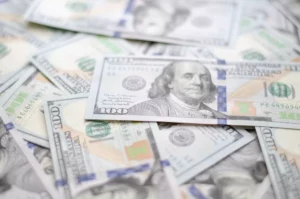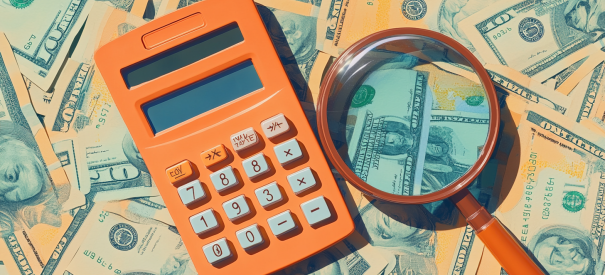TABLE OF CONTENTS
When you need business financing, you take out a loan, cash advance, or another form of funding, then you pay back the money borrowed with interest. In some cases, the interest is expressed as a decimal, called a “factor rate.” Below, find out what this is, how it works, and how it’s calculated to see if it’s the right interest mechanism for your particular business.
What Is Factor Rate?

Small-business owners have a variety of financing options to help keep their doors open and businesses running successfully. And if you’ve recently applied for a form of business financing, it’s possible you heard the term factor rate, also commonly called money factor or buy rate.
Less common than interest rates and APRs, factor rates are the amount of interest a financial institution—typically an alternative, non-bank lender—charges for your cash advance. Expressed as a decimal, typically ranging from 1.1 to 1.5, the factor rate is the amount you owe over and above your original funding amount.
How Does a Factor Rate Work for Small Businesses?
Factor rates are applied to business loans, not personal loans. Small businesses and merchants needing a fast infusion of cash often apply for short-term funding in the form of a merchant cash advance or another alternative source of financing, which may be subject to a factor rate. Factor rates are seldom applied to standard business loans.
Factor rates are charged on the original amount borrowed, unlike interest rates. The cost of borrowing neither compounds nor changes as you pay off the funds. You usually make daily or weekly payments through automated ACH payments or a business merchant processor. Until the balance is paid in full, a percentage of your daily sales is deducted as payment.
Note: Your business must generate at least $10,000 per month in sales to qualify for a merchant cash advance.
Factor Rate vs Interest Rate
An interest rate is a percentage of the principal. Meanwhile, an annual percentage rate (APR) is the total annual cost of borrowing, including the interest rate and additional fees. Unlike interest rates, which can compound as you pay off your debt, factor rates apply only to the original amount. Below highlights the key differences between these rates.
Factor rates
- Shown as a decimal
- Only applies to the original amount borrowed
- Applied to merchant cash advances and alternative types of financing
Interest rates
- Shown as an annualized percentage
- Only applies to the remaining balance of the borrowed amount
- Applied to many kinds of financing, including credit cards, personal loans, and more
How to Calculate Factor Rate
Lenders express factor rates as decimals. They calculate this upfront and it never changes. It’s important to keep in mind that although a factor rate of 1.2 sounds low, it is comparable to an interest rate of 120 percent. Before agreeing to terms, you should take the time to understand just how much you’ll pay for your funding amount.
To figure out the total cost you’ll pay over the course of your cash advance, multiply your borrowed amount by the factor rate. The total is what you will be responsible for paying back to your lender. This is the equation: factor rate x advance amount = total payback amount.
Let’s say you take a $12,000 merchant cash advance that has a 1.35 factor rate. To determine how much you’ll repay to your lender, multiply your funding amount by the factor rate: $12,000 x 1.35 = $16,200. You will repay $16,200 to borrow $12,000.
Cash advances are some of the most expensive funding products available. That’s because, unlike a loan, no personal guarantee is required to secure the advance amount.
How to Convert Factor Rate into Annual Percentage Rate (APR)
To calculate the APR, you simply add in cash advance fees and other charges included with the advance. However, you need to convert the factor rate in order to calculate the APR. Below walks you through exactly how to do this.
1. Determine the payback amount
Multiply the cash advance amount by the factor rate ($12,000 x 1.35 = $16,200) and calculate the difference ($16,200 – $12,000 = $4,200). The payback amount is $4,200.
2. Calculate percentage costs
Next, you need to determine the percentage cost of the payback amount. Divide the payback amount by the cash advance amount to get a decimal: $4,200 / $12,000 = .35.
Then, to determine the interest rate when annualized, multiple .35 by 365 (the days in a year): .35 X 365 = $127.75.
3. Determine the annualized interest rate
In the final step, divide the annualized interest rate by the advance term (in days) to find the annualized rate. Let’s say the length of the term is six months or 182 days. The equation would be: 127.75 / 182 = 0.7019. Finally, convert this number into a percentage by moving the decimal: 70.19%.
In the above example, you’ll pay a 70% APR to borrow $12,000.
How Lenders Calculate Your Factor Rate
Although factor rates are rather clear-cut, lenders may take into consideration several business characteristics, such as:

- Your business’s industry: Some lenders will consider the industry you’re in to assess your business’s potential for growth.
- Your projected average monthly credit card sales: An upward trend in credit card sales can go a long way in determining your factor rate.
- The strength and stability of your sales: Lenders will likely request your business bank statements and tax returns to assess the financial stability and strength of your business.
- The length of time you’ve been in business: Most lenders require at least one year in business. Although, this depends on the lender, as some will provide cash advances even if you’ve been in business only a few months.
FAQs
Below are answers to the most frequently asked questions related to factor rates.
Is a factor rate better than an APR or interest rate?
That depends. With a factor rate, payments are deducted from a percentage of your daily sales. Not only is repayment automated, but you also pay no compounding interest. Additionally, elements like your business’s credit score and years in operation do not typically play a role in your business qualifying for a cash advance. However, factor rate financing can be more expensive and provide less time to repay what you borrow.
How are interest rates determined?
Interest rates are determined in three ways[1]Federal Reserve. “Open Market Operations“. Accessed May 5, 2022.:
- The Federal Reserve sets the federal funds rate, which affects variable and short-term interest rates.
- Investor demand for U.S. Treasury notes and bonds affects fixed-rate and long-term financing rates.
- The banking industry provides loans and mortgages, which can alter interest rates.
Are factor rates usually higher than interest rates?
While the cost you pay to borrow working capital depends on many variables, typically interest rates come in at a lower cost than factor rate arrangements.
What is a payment factor?
Your lender calculated your factor rate upfront. Unlike an interest rate, your factor rate never changes. Usually, you will make repayments daily or weekly until the balance is paid in full. These payments may be referred to as your “payment factor.”
Final Thoughts
While there are many business financing options, some require your business to pass certain qualifying criteria. Other business financing options are based mostly on your business’s ability to generate future sales. However, most alternative forms of financing are subject to factor rates. There are benefits and pitfalls in regards to factor rate financing, but businesses needing a short-term influx of cash fast may find that even the disadvantages are worth overlooking in order to quickly access the capital they need.






